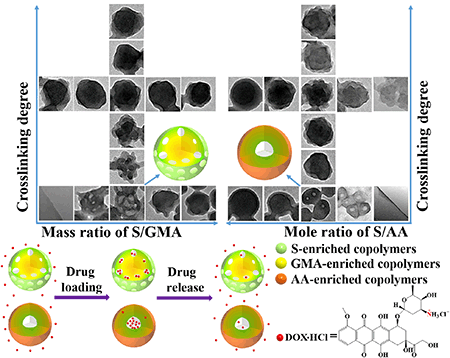Nano Research ( IF 9.5 ) Pub Date : 2017-06-01 , DOI: 10.1007/s12274-017-1492-8 Xinlong Fan , Jin Liu , Xiangkun Jia , Yin Liu , Hao Zhang , Shenqiang Wang , Baoliang Zhang , Hepeng Zhang , Qiuyu Zhang
A facile one-step approach to synthesize various phase-separated porous, raspberry-like, flower-like, core–shell and anomalous nanoparticles and nanocapsules via 1,1-diphenylethene (DPE) controlled soap-free emulsion copolymerization of styrene (S) with glycidyl methacrylate (GMA), or acrylic acid (AA) is reported. By regulating the mass ratio of S/GMA, transparent polymer solution, porous and anomalous P(S-GMA) particles could be produced. The P(S-GMA) particles turn from flower-like to raspberry-like and then to anomalous structures with smooth surface as the increase of divinylbenzene (DVB) crosslinker. Transparent polymer solution, nanocapsules and core–shell P(S-AA) particles could be obtained by altering the mole ratio of S/AA; anomalous and raspberry-like P(S-AA) particles are produced by adding DVB. The unpolymerized S resulted from the low monomer conversion in the presence of DPE aggregates to form nano-sized droplets, and migrates towards the external surfaces of the GMA-enriched P(S-GMA) particles and the internal bulk of the AA-enriched P(S-AA) particles. The nano-sized droplets function as in situ porogen, porous P(S-GMA) particles and P(S-AA) nanocapsules are produced when the porogen is removed. This novel, facile, one-step method with excellent controllability and reproducibility will inspire new strategies for creating hierarchical phase-separated polymeric particles with various structures by simply altering the species and ratio of comonomers. The drug loading and release experiments on the porous particles and nanocapsules demonstrate that the release of doxorubicin hydrochloride is very slow in weakly basic environment and quick in weakly acidic environment, which enables the porous particles and nanocapsules with promising potential in drug delivery applications.

中文翻译:

1,1-二苯乙烯控制的一步无皂乳液共聚合分离的一系列相分离纳米粒子及其在药物释放中的应用
一种简便的一步法,通过1,1-二苯乙烯(DPE)控制的苯乙烯无皂乳液共聚,合成各种相分离的多孔,树状,花状,核-壳和反常的纳米颗粒和纳米胶囊。据报道有甲基丙烯酸缩水甘油酯(GMA)或丙烯酸(AA)。通过调节S / GMA的质量比,可以制得透明的聚合物溶液,多孔和反常的P(S-GMA)颗粒。随着二乙烯基苯(DVB)交联剂的增加,P(S-GMA)颗粒从花状变为树莓状,然后变为具有光滑表面的异常结构。可以通过改变S / AA的摩尔比来获得透明的聚合物溶液,纳米胶囊和核-壳P(S-AA)颗粒。通过添加DVB可以产生异常和类似树莓的P(S-AA)颗粒。未聚合的S是由于在DPE聚集体的存在下单体转化率低而形成的纳米级液滴,并向富含GMA的P(S-GMA)颗粒的外表面和富含AA的P的内部体积迁移(S-AA)颗粒。纳米大小的液滴起原位成孔剂的作用,去除成孔剂后会产生多孔的P(S-GMA)颗粒和P(S-AA)纳米胶囊。这种新颖,简便,一步法具有出色的可控性和可重复性,将激发通过简单改变共聚单体的种类和比例来创建具有各种结构的分层相分离聚合物颗粒的新策略。










































 京公网安备 11010802027423号
京公网安备 11010802027423号